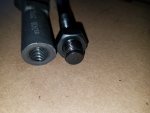Another greasable vs greasable question. Check this out. Is it normal for the greased tie rod end to be thicker than a non greasable one? Does the thickness matter?
The length of the ball stud taper is all that is important, the inner and outer taper should fit snugly with no play and have enough threads to properly tighten and the boot to compress the correct amount. The LFL is a much easier joint to live with and in many cases last much longer.



